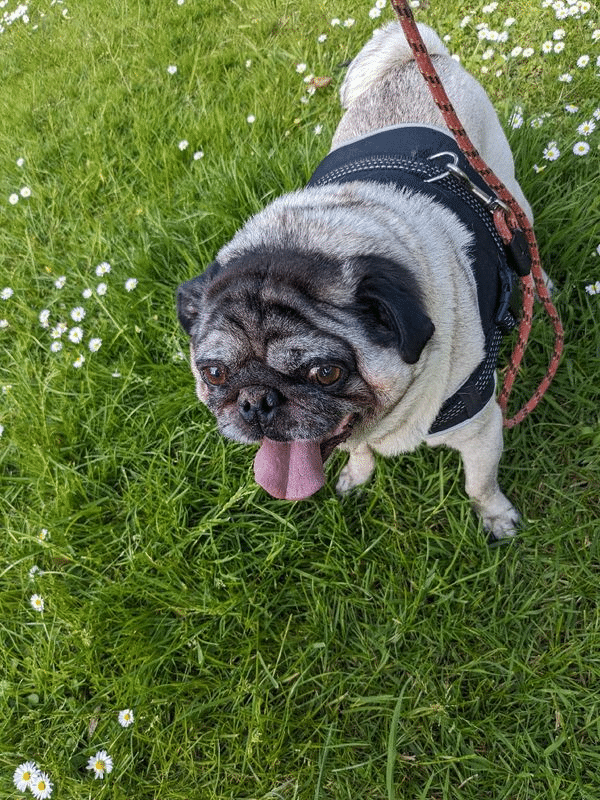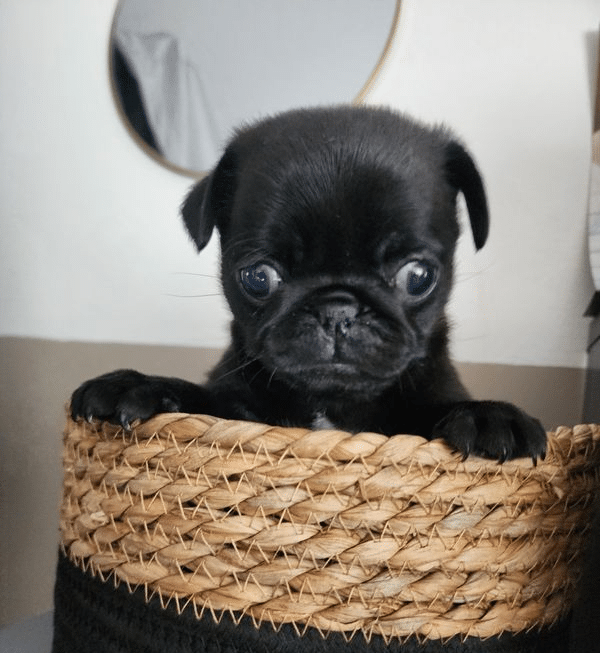Unfortunately, yes, Pugs’ eyes can pop out, and it’s a serious condition called proptosis. Because their eye sockets are shallower than other breeds due to their short snouts, even minor trauma can cause an eye to dislodge.
This is an emergency situation, and your Pug needs immediate veterinary attention. Every minute counts when it comes to saving their eye and vision. While there are online resources with risky procedures to try at home if you can’t reach a vet within minutes, it’s strongly discouraged. A vet has the expertise and equipment to give your Pug the best chance of recovery.
Preventing Pugs Eye Proptosis

Eye proptosis is incredibly painful and scary for your Pug. Here’s how to minimize the risk:
- Quick and Gentle Handling: Be mindful when handling your Pug, avoiding any rough play or squeezing around their face.
- Harness the Power of Harnesses: Skip the collar and use a harness instead. Tight collars or tugging on a leash can put pressure on the neck and potentially cause proptosis.
- Beware of Sneezes: Believe it or not, even a forceful sneeze can dislodge an eye in a Pug. So, keep an eye out for anything that might trigger a violent sneeze.
Pugs, with their adorable wrinkles and smooshed faces, belong to a category of dogs called brachycephalics. These are the breeds with super short skulls, which can lead to some unique health challenges. One of the most surprising issues vets encounter with Pugs is their eyes popping out of their sockets! This scary-sounding condition is called proptosis, and it can happen due to trauma to the head or face, like a dog bite, a fall, or even a bump. In this article, we’ll explore why this occurs, what signs to watch for, and what to do if your Pug’s eye decides to make a break for it.
The Short Snout, the Shallow Socket
The culprit behind eye proptosis in Pugs is their unique anatomy. Pugs, along with other brachycephalic breeds, have been bred to have shortened skulls, resulting in those adorable flat faces. Unfortunately, this cuteness comes at a cost.
Because their skulls are shorter, there’s simply not enough space for their eyes to sit deep within the sockets like in other dogs. This means their eyes appear bulging and more exposed, even though they might be normal sized. Think of it like having a house with shallow windows compared to one with deep window wells.
This lack of bony protection makes their eyes vulnerable to popping out under pressure. Even seemingly minor things like:
- Squeezing their face during play
- Using a tight collar or pulling on a leash
- Forceful sneezing
can create enough pressure to dislodge an eye. This is why harnesses are recommended for Pugs, as they distribute pressure more evenly across the chest and shoulders.
Emergency! Get Help Immediately
If your Pug’s eye pops out, it’s a critical situation. Seek immediate veterinary attention. Every minute counts when it comes to saving their eye and vision. Don’t attempt any at-home remedies you might find online. These can be dangerous and worsen the injury.
Here’s what you can do while waiting for veterinary help:
- Stay Calm: It’s scary, but staying calm will help you handle the situation effectively.
- Minimize Movement: Gently pick up your Pug and limit their movement to avoid further dislodging the eye.
- Protect the Eye: If possible, use a clean, damp cloth to loosely cover the exposed eye. Don’t apply pressure or try to push the eye back into the socket.
- E-Collar for Protection: If you have an Elizabethan collar (cone) on hand, put it on your Pug to prevent them from scratching or rubbing the eye, which could cause more damage.
At the Vet’s Office
Your veterinarian will examine your Pug’s eye and any other injuries. Treatment options may include:
- Repositioning the Eye: If possible, the vet will gently reposition the eye back into the socket.
- Medication: Antibiotics or pain medication may be prescribed.
- Surgery: In some cases, surgery may be necessary to repair damaged tissue or address the underlying cause of proptosis.
Preventing Future Episodes
Once your Pug recovers, discuss preventative measures with your veterinarian. These might include:
- Careful Handling: Avoid rough play or squeezing around their face.
- Harness Use: Stick to a harness instead of a collar to prevent pressure on the neck.
- Awareness of Sneezing: Watch out for anything that might trigger a forceful sneeze.
Treatment: A Race Against Time
The treatment your Pug receives depends on the severity of the trauma and the resulting damage to the eye. Your veterinarian will carefully examine the eye, surrounding muscles, and soft tissues to assess the situation. This helps determine if the eye can be saved.
Surgery: The Most Likely Course
In almost all cases of eye proptosis, surgery is necessary. The type of surgery will depend on the specific damage:
- Replacement: If the eyeball itself is intact, the vet might be able to gently reposition it back into the socket during surgery. Sutures will then be placed to hold everything in place while healing occurs.
- Removal: Unfortunately, sometimes the eye is too damaged to be saved. In these cases, surgery will involve complete removal of the eye and possibly some surrounding tissues.
The Importance of Early Action
The sooner you get your Pug to the vet after their eye pops out, the better their chances of a successful outcome. Early intervention can significantly increase the likelihood of saving the eye and vision. Remember, time is critical in these situations.
Vision Loss: A Potential Outcome
Whether your Pug loses vision in the affected eye depends on several factors, primarily the extent of the damage:
- Ruptured Eyeball: If the eyeball itself has burst, there’s little chance of salvaging it. In these cases, surgery will likely involve removing the entire eye, resulting in permanent blindness in that eye. The good news is, your Pug should still be able to see out of their remaining eye.
- Replaced Eye: Even if the eyeball is successfully repositioned, vision loss in that eye is still a possibility. So, while your Pug might appear “normal” after surgery, they may only have vision in one eye.
The Risk of Recurrence
Remember, the underlying issue – the short skull and shallow sockets – hasn’t changed. This means there’s a chance the proptosis could reoccur, potentially affecting the other eye.
Additionally, swelling after surgery can sometimes push the replaced eye back out once the sutures are removed. In these situations, removal of the affected eye may be necessary.
Living a Happy Life with One Eye
Pugs who lose vision in one eye can still live happy and fulfilling lives. They adapt remarkably well to monocular vision. With some adjustments to their environment and routine, your Pug can continue to enjoy a full and active life.
Living Life to the Fullest with Your Pug

Pugs, with their charming personalities and adorable wrinkles, come with a unique set of health considerations due to their brachycephalic anatomy. One potential concern is eye proptosis, where their eyes can pop out from even minor pressure. While this sounds scary, early veterinary intervention is crucial for the best possible outcome.
Understanding the risks and acting quickly can significantly increase the chances of saving your Pug’s eye and vision. However, even with treatment, vision loss in the affected eye is a possibility.
The good news is that Pugs can adapt remarkably well to monocular vision and live happy, fulfilling lives. By providing a loving home, taking preventive measures like using a harness, and being mindful of potential risks, you can ensure your precious Pug companion thrives for many years to come.
Pug Eye FAQ: Answering Your Pressing Questions
Can Pugs close their eyes?
Absolutely! Pugs have normal eyelids just like any other dog. They can blink, close their eyes for sleep, and squint in bright light.
Do French Bulldogs’ eyes fall out?
Yes, French Bulldogs, along with other brachycephalic breeds like Shih Tzus and Pekingese, are also susceptible to eye proptosis (eye popping) due to their shortened skulls and shallow eye sockets.
Do Pugs have eye sockets?
Yes, Pugs do have eye sockets, but they are shallower than those of dogs with normal-length skulls. This shallowness is what contributes to the risk of their eyes popping out.
What to do if my dog’s eye pops out?
This is a veterinary emergency! Here’s what to do:
- Stay Calm: It’s scary, but staying calm will help you handle the situation effectively.
- Minimize Movement: Gently pick up your dog and limit their movement to avoid further dislodging the eye.
- Protect the Eye: If possible, use a clean, damp cloth to loosely cover the exposed eye. Don’t apply pressure or try to push the eye back into the socket.
- Seek Immediate Veterinary Care: Get your dog to the vet as quickly as possible. Time is critical in these situations.




